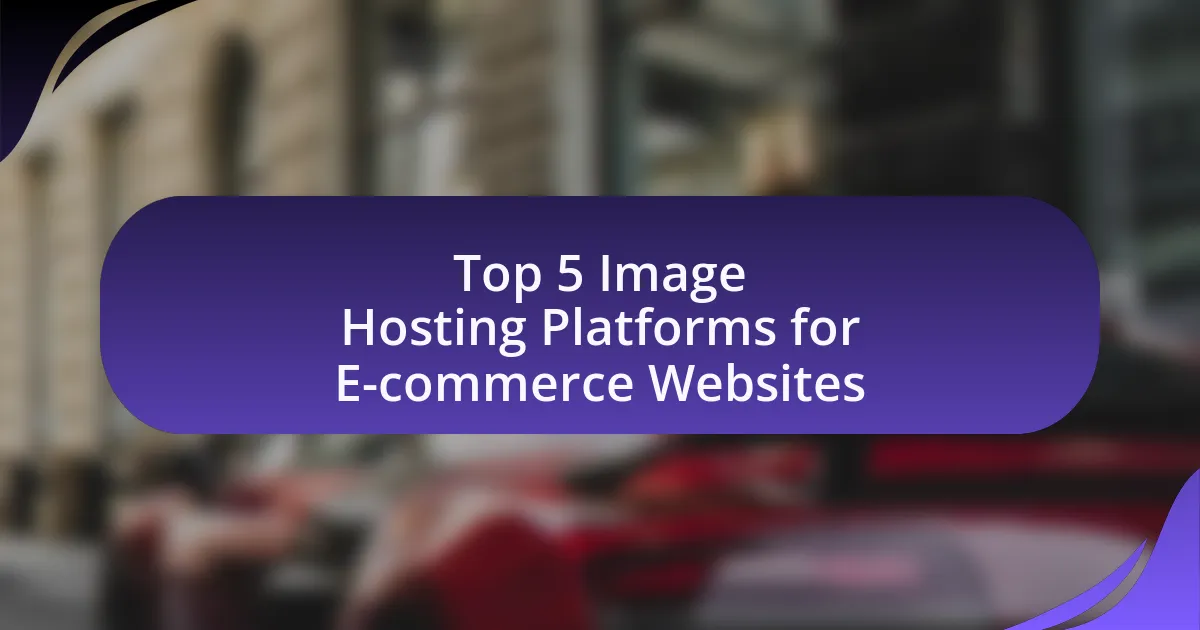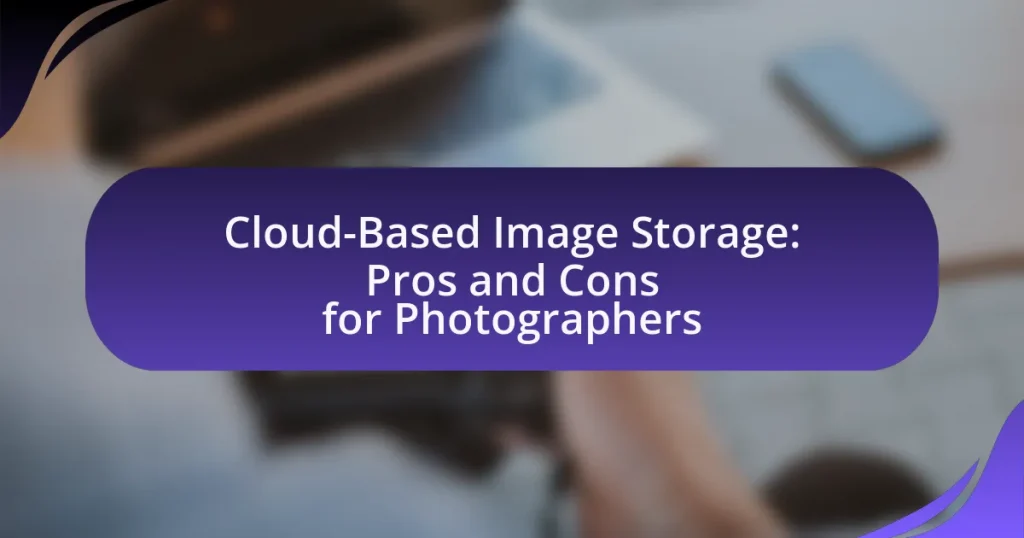The article focuses on the top five image hosting platforms for e-commerce websites: Amazon S3, Google Cloud Storage, Cloudinary, Imgix, and Flickr. It examines how these platforms enhance the e-commerce experience through fast, reliable image hosting, which improves website performance and user engagement. Key features such as storage capacity, loading speeds, and security measures are discussed, along with the implications of image hosting on conversion rates and customer trust. Additionally, the article outlines best practices for optimizing images and selecting the right hosting platform based on business needs.
What are the Top 5 Image Hosting Platforms for E-commerce Websites?
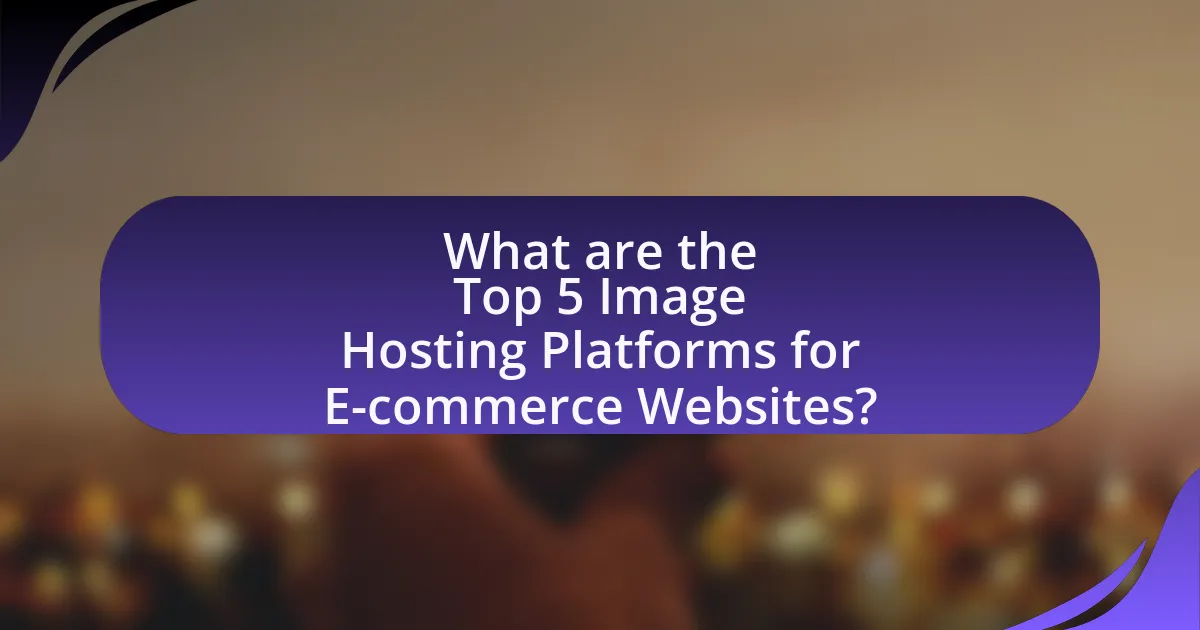
The top 5 image hosting platforms for e-commerce websites are Amazon S3, Google Cloud Storage, Cloudinary, Imgix, and Flickr. Amazon S3 offers scalable storage with high durability and availability, making it suitable for e-commerce needs. Google Cloud Storage provides robust security and integration with other Google services, enhancing user experience. Cloudinary specializes in image management and optimization, allowing for dynamic image transformations. Imgix focuses on real-time image processing and delivery, ensuring fast load times. Flickr, while primarily a photo-sharing platform, offers a reliable option for hosting images with community engagement features. These platforms are widely recognized for their performance, scalability, and features tailored to e-commerce.
How do these platforms enhance the e-commerce experience?
These platforms enhance the e-commerce experience by providing fast, reliable image hosting that improves website performance and user engagement. High-quality images hosted on these platforms load quickly, reducing bounce rates and increasing the likelihood of conversions. For instance, studies show that a one-second delay in page load time can lead to a 7% reduction in conversions. Additionally, these platforms often offer features like automatic image optimization and responsive design, ensuring that images display correctly on various devices, which is crucial as mobile commerce continues to grow. By utilizing these services, e-commerce websites can create a visually appealing and efficient shopping experience that meets customer expectations.
What features make these platforms suitable for e-commerce?
The features that make image hosting platforms suitable for e-commerce include high storage capacity, fast loading speeds, and robust security measures. High storage capacity allows businesses to upload and manage a large number of product images without compromising quality. Fast loading speeds enhance user experience by reducing the time it takes for images to appear, which is crucial for retaining potential customers. Robust security measures protect sensitive data and images from unauthorized access, ensuring that both the business and customer information remain safe. These features collectively contribute to a seamless and secure shopping experience, which is essential for e-commerce success.
How do these platforms improve website performance?
These platforms improve website performance by optimizing image delivery and reducing load times. They achieve this through techniques such as image compression, which minimizes file sizes without sacrificing quality, and content delivery networks (CDNs) that distribute images across multiple servers globally, ensuring faster access for users. For instance, platforms like Cloudinary and Imgix automatically adjust image sizes based on user device and screen resolution, enhancing loading speed and user experience. Studies show that faster loading times can lead to higher conversion rates, with a 1-second delay potentially reducing conversions by 7%.
Why is image hosting important for e-commerce websites?
Image hosting is crucial for e-commerce websites because it enhances website performance and user experience. Fast-loading images improve page speed, which is a significant factor in search engine rankings and customer retention; studies show that a one-second delay in loading time can lead to a 7% reduction in conversions. Additionally, reliable image hosting ensures high-quality visuals are consistently displayed, which is essential for showcasing products effectively and building consumer trust. Furthermore, effective image hosting solutions often provide features like automatic image optimization and responsive design, which further enhance the overall shopping experience.
What role do images play in online shopping?
Images play a crucial role in online shopping by significantly influencing consumer purchasing decisions. High-quality images enhance product visibility, allowing customers to assess details, colors, and textures, which are essential for making informed choices. Research indicates that 93% of consumers consider visual appearance as a key factor in their buying decisions, highlighting the importance of images in e-commerce. Furthermore, effective imagery can lead to increased engagement and lower return rates, as customers have a clearer understanding of what they are purchasing.
How can image hosting affect conversion rates?
Image hosting can significantly affect conversion rates by influencing website loading speed, user experience, and image quality. Faster loading times, facilitated by efficient image hosting, lead to lower bounce rates; studies show that a one-second delay in page load time can reduce conversions by 7%. Additionally, high-quality images hosted on reliable platforms enhance product presentation, which can increase customer trust and engagement, ultimately driving higher sales. Research indicates that 67% of consumers consider image quality very important in their purchasing decisions, underscoring the impact of image hosting on conversion rates.
What are the key features to consider in an image hosting platform?
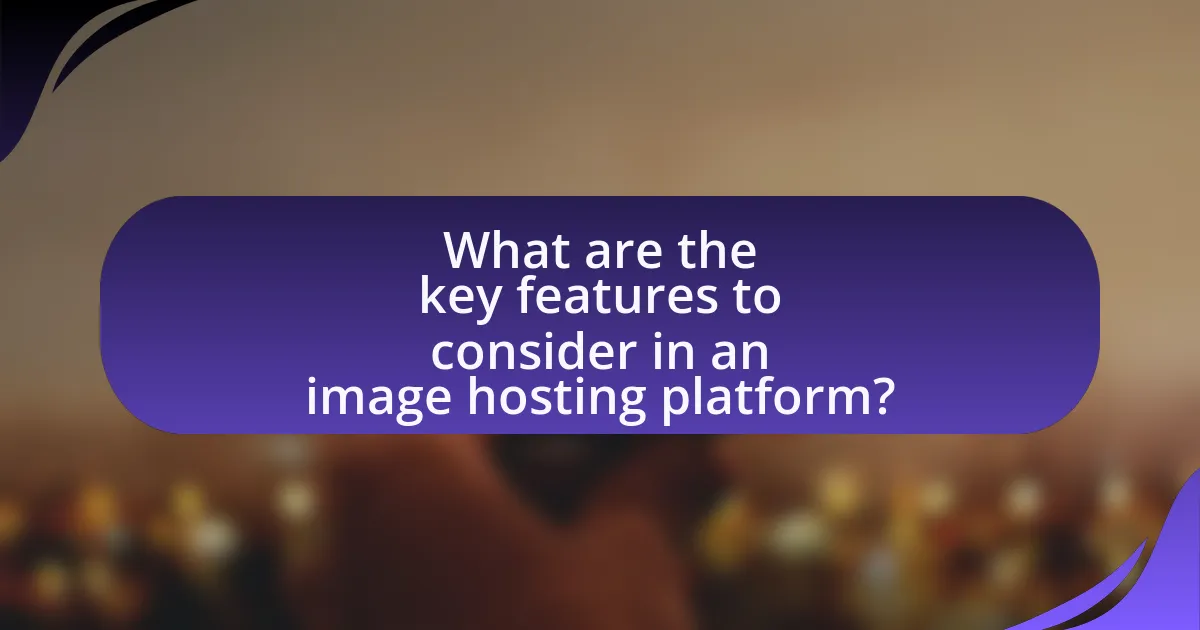
Key features to consider in an image hosting platform include storage capacity, upload speed, image quality, security measures, and user interface. Storage capacity is crucial as it determines how many images can be stored without additional costs; for instance, platforms like Amazon S3 offer scalable storage solutions. Upload speed affects how quickly users can add images, which is essential for e-commerce efficiency. Image quality ensures that images are displayed in high resolution, impacting customer perception; platforms like Cloudinary optimize images for web use. Security measures, such as SSL encryption and access controls, protect sensitive data, which is vital for e-commerce transactions. Lastly, a user-friendly interface enhances the overall experience, making it easier for users to manage their images effectively.
How does storage capacity impact e-commerce image hosting?
Storage capacity directly influences e-commerce image hosting by determining the volume and quality of images that can be stored and served to customers. A higher storage capacity allows e-commerce platforms to host a larger number of high-resolution images, which enhances product presentation and customer engagement. For instance, platforms with limited storage may require image compression or reduction in quality, potentially affecting the visual appeal and user experience. Additionally, ample storage capacity supports the inclusion of diverse media types, such as videos and 360-degree views, which can lead to increased conversion rates. Therefore, adequate storage is essential for maintaining a competitive edge in the e-commerce landscape.
What are the implications of limited storage on product listings?
Limited storage on product listings restricts the number of images and details that can be displayed for each product. This limitation can lead to reduced customer engagement, as potential buyers may not have access to sufficient visual information to make informed purchasing decisions. Research indicates that listings with multiple high-quality images can increase conversion rates by up to 30%, highlighting the importance of adequate storage for effective product representation. Additionally, limited storage may necessitate the prioritization of certain products over others, potentially impacting overall sales and inventory turnover.
How can unlimited storage benefit large e-commerce sites?
Unlimited storage can significantly benefit large e-commerce sites by allowing them to store vast amounts of product images, customer data, and multimedia content without the constraints of traditional storage limits. This capability enables e-commerce platforms to enhance user experience through high-quality visuals and extensive product catalogs, which are crucial for attracting and retaining customers.
Moreover, unlimited storage supports the scalability of e-commerce operations, accommodating growth in inventory and customer base without requiring frequent upgrades or migrations to new storage solutions. For instance, a study by Statista indicates that 75% of consumers prefer shopping on sites with rich media content, highlighting the importance of having ample storage for images and videos. Thus, unlimited storage not only facilitates operational efficiency but also directly contributes to improved customer engagement and sales performance.
What security measures should be prioritized in image hosting?
Prioritized security measures in image hosting include data encryption, access control, and regular security audits. Data encryption protects images during transmission and storage, ensuring that unauthorized users cannot access sensitive content. Access control mechanisms, such as user authentication and permission settings, restrict who can upload, view, or modify images, thereby minimizing the risk of data breaches. Regular security audits help identify vulnerabilities and ensure compliance with security standards, which is crucial for maintaining the integrity of the image hosting platform. These measures collectively enhance the overall security posture of image hosting services, safeguarding both the images and user data.
How do SSL certificates protect image data?
SSL certificates protect image data by encrypting the data transmitted between a user’s browser and the server hosting the images. This encryption ensures that any image data sent over the internet is secure from interception or tampering by unauthorized parties. For instance, when a user accesses an e-commerce website, SSL certificates create a secure connection, indicated by “https” in the URL, which protects sensitive information, including images, from being accessed or altered during transmission. This security measure is crucial for maintaining user trust and safeguarding proprietary content on e-commerce platforms.
What are the risks of inadequate security in image hosting?
Inadequate security in image hosting poses significant risks, including data breaches, unauthorized access, and loss of intellectual property. These vulnerabilities can lead to sensitive images being exposed or manipulated, resulting in reputational damage for businesses and potential legal consequences. For instance, a study by Verizon in their 2020 Data Breach Investigations Report highlighted that 22% of data breaches involved web applications, which often include image hosting services. Additionally, insecure image hosting can facilitate phishing attacks, where attackers use compromised images to deceive users. Overall, the lack of robust security measures can severely impact both the integrity of the hosted content and the trust of users in the platform.
How do the top 5 platforms compare in terms of pricing and plans?

The top 5 image hosting platforms for e-commerce websites—Amazon S3, Google Cloud Storage, Dropbox, SmugMug, and ImageShack—vary significantly in pricing and plans. Amazon S3 offers a pay-as-you-go model with costs starting at $0.023 per GB for the first 50 TB, while Google Cloud Storage has a similar structure, beginning at $0.020 per GB for the first 1 TB. Dropbox provides a subscription model with plans starting at $12.50 per month for 2 TB of storage. SmugMug offers tiered plans starting at $7 per month for unlimited storage, and ImageShack has a basic plan starting at $3.99 per month for 10 GB. These differences highlight the range of options available, catering to various storage needs and budgets in the e-commerce sector.
What are the pricing structures of these platforms?
The pricing structures of the top image hosting platforms for e-commerce websites vary significantly. For instance, platforms like Shopify offer plans starting at $29 per month, which includes image hosting as part of their e-commerce services. In contrast, platforms such as SmugMug provide tiered pricing, ranging from $7 to $42 per month, depending on the features and storage capacity selected. Additionally, services like Amazon S3 charge based on usage, with costs calculated per gigabyte stored and transferred, making it a pay-as-you-go model. Other platforms, like Flickr, offer a free tier with limited storage and a Pro subscription at $6.99 per month for unlimited storage and additional features. These diverse pricing structures cater to different business needs and budgets, allowing e-commerce websites to choose based on their specific requirements.
How do free plans differ from paid plans?
Free plans typically offer limited storage, bandwidth, and features compared to paid plans. For instance, free plans may restrict the number of images that can be uploaded or the resolution of those images, while paid plans often provide higher storage limits, advanced features like analytics, and priority customer support. Additionally, free plans may include advertisements or branding from the hosting service, whereas paid plans usually allow for a more professional, ad-free experience.
What hidden costs should e-commerce businesses be aware of?
E-commerce businesses should be aware of hidden costs such as transaction fees, shipping expenses, and subscription charges for software and services. Transaction fees can range from 2% to 5% per sale, depending on the payment processor, which can significantly impact profit margins. Shipping expenses often exceed initial estimates due to packaging, handling, and unexpected surcharges, leading to increased operational costs. Additionally, subscription charges for essential tools like inventory management, customer relationship management, and image hosting services can accumulate, with some platforms costing upwards of $100 monthly. Understanding these hidden costs is crucial for accurate budgeting and financial planning in e-commerce.
What are the user experiences and reviews for these platforms?
User experiences and reviews for the top image hosting platforms for e-commerce websites generally highlight reliability, speed, and ease of use. Users frequently commend platforms like Shopify for its seamless integration with e-commerce tools, while others appreciate the robust features of Amazon S3, which is noted for its scalability and performance. Reviews often mention that platforms such as Imgur and Flickr provide user-friendly interfaces, making it easy for non-technical users to upload and manage images. Additionally, Google Photos is praised for its organizational capabilities and automatic backup features, enhancing user experience. Overall, feedback indicates that these platforms effectively meet the needs of e-commerce businesses by providing efficient image hosting solutions.
How do customer support services vary among the platforms?
Customer support services vary significantly among image hosting platforms for e-commerce websites, with differences in availability, response time, and support channels. For instance, some platforms offer 24/7 live chat support, ensuring immediate assistance, while others may limit support hours to business days, resulting in longer wait times for users. Additionally, certain platforms provide extensive self-help resources, such as FAQs and tutorials, which can reduce the need for direct support, whereas others may rely heavily on email support, which can lead to delays in resolution. The level of personalized support also differs; some platforms assign dedicated account managers for premium users, enhancing the support experience, while others offer more generic support to all users. These variations impact user satisfaction and the overall effectiveness of customer support across different platforms.
What common issues do users face with these platforms?
Users commonly face issues such as slow loading times, limited storage capacity, and inadequate customer support with image hosting platforms for e-commerce websites. Slow loading times can negatively impact user experience and conversion rates, as studies show that a one-second delay can reduce conversions by 7%. Limited storage capacity restricts the number of images that can be uploaded, which is crucial for e-commerce sites that require extensive product visuals. Additionally, inadequate customer support can lead to prolonged downtime and unresolved technical issues, affecting overall site performance and user satisfaction.
What are the best practices for using image hosting platforms in e-commerce?
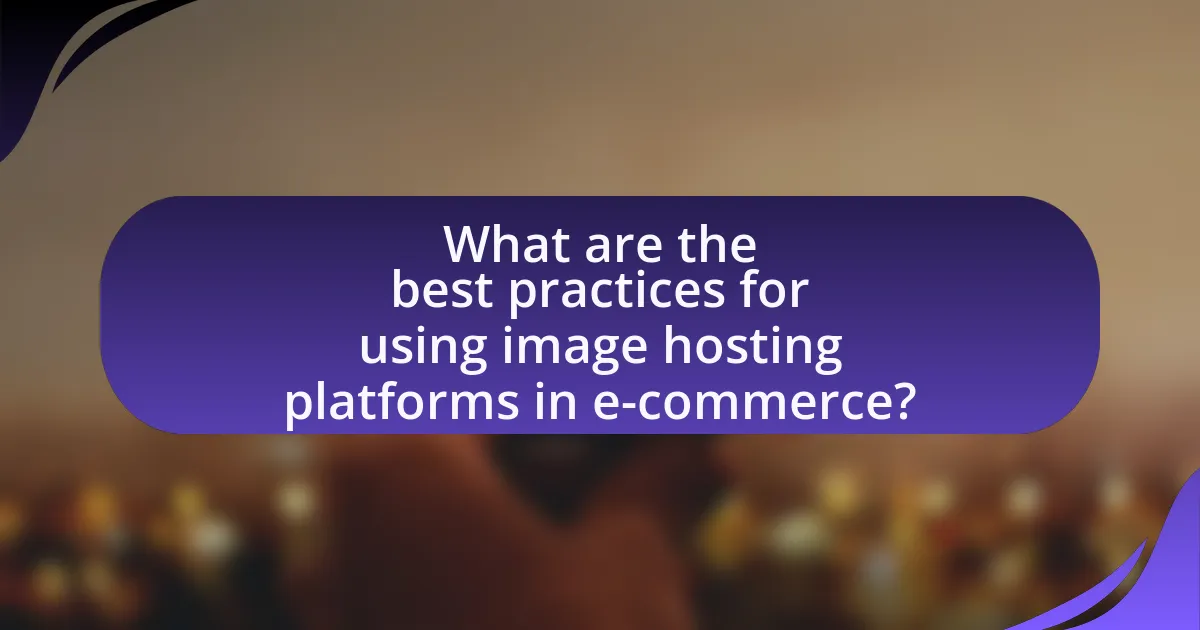
The best practices for using image hosting platforms in e-commerce include optimizing image sizes for faster loading times, using descriptive file names and alt text for better SEO, and ensuring high-quality images to enhance customer experience. Optimizing image sizes can reduce page load times by up to 70%, which is crucial as studies show that a one-second delay in loading can lead to a 7% reduction in conversions. Descriptive file names and alt text improve search engine visibility, making products easier to find; for instance, using “red-leather-handbag.jpg” instead of “IMG1234.jpg” can significantly enhance SEO. High-quality images, ideally with multiple angles and zoom features, help customers make informed purchasing decisions, as 93% of consumers consider visual appearance to be the key deciding factor in a purchase.
How can e-commerce businesses optimize images for better performance?
E-commerce businesses can optimize images for better performance by compressing them to reduce file size without sacrificing quality. This can be achieved using tools like TinyPNG or ImageOptim, which can decrease loading times significantly; studies show that a 1-second delay in page load time can lead to a 7% reduction in conversions. Additionally, using the appropriate file formats, such as JPEG for photographs and PNG for graphics with transparency, enhances performance. Implementing responsive images that adjust to different screen sizes also improves user experience and loading efficiency. Finally, utilizing a content delivery network (CDN) can further enhance image loading speeds by distributing images across multiple servers globally, ensuring faster access for users.
What image formats are best for web use?
The best image formats for web use are JPEG, PNG, GIF, SVG, and WebP. JPEG is ideal for photographs due to its efficient compression, which maintains quality while reducing file size. PNG supports transparency and is suitable for images requiring high detail, such as logos. GIF is commonly used for simple animations and graphics with limited colors. SVG is a vector format that scales without losing quality, making it perfect for logos and icons. WebP offers superior compression and quality, making it a strong choice for modern web applications. These formats are widely supported across browsers and optimize loading times, enhancing user experience on e-commerce websites.
How does image compression affect loading times?
Image compression significantly reduces loading times by decreasing the file size of images without substantially compromising quality. Smaller file sizes lead to faster data transfer rates, which is crucial for user experience on e-commerce websites. Research indicates that optimized images can improve page load speed by up to 80%, directly impacting conversion rates and user retention. For instance, a study by Google found that a one-second delay in loading time can lead to a 20% decrease in conversions, highlighting the importance of image compression in enhancing website performance.
What tips can help in choosing the right image hosting platform?
To choose the right image hosting platform, prioritize factors such as storage capacity, speed, security, and ease of integration with your e-commerce website. Storage capacity is crucial as it determines how many images you can host; platforms like Amazon S3 offer scalable storage solutions. Speed affects user experience, so select a platform with fast loading times, which can be verified through performance benchmarks. Security is essential to protect your images from unauthorized access, and platforms that provide SSL encryption are preferable. Lastly, ensure the platform integrates seamlessly with your e-commerce tools, as this can streamline your workflow and enhance functionality.
How can businesses assess their specific needs before selecting a platform?
Businesses can assess their specific needs before selecting a platform by conducting a thorough analysis of their operational requirements, target audience, and technical capabilities. This involves identifying the volume of images they need to host, the expected traffic, and the types of images (e.g., product photos, user-generated content) they will manage. Additionally, businesses should evaluate their budget constraints and the level of customer support required. According to a survey by Clutch, 64% of small businesses prioritize cost-effectiveness when choosing a platform, highlighting the importance of aligning platform features with financial resources. By systematically analyzing these factors, businesses can make informed decisions that align with their unique needs.
What factors should be prioritized based on business size and type?
Businesses should prioritize scalability, cost, and integration capabilities based on their size and type. For small businesses, cost-effective solutions with easy integration into existing platforms are crucial, as they often operate with limited budgets and resources. In contrast, larger enterprises should focus on scalability to handle high volumes of traffic and data, ensuring that the image hosting platform can grow alongside their business needs. Additionally, the type of business, such as B2C or B2B, influences the choice of features like security and customization options, which are essential for maintaining brand integrity and customer trust.
